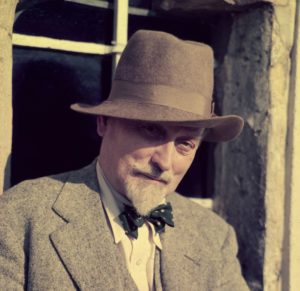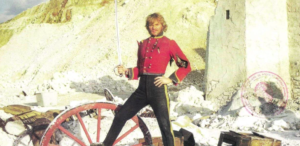“To gaze into the depths of the sea is, in the imagination, like beholding the vast unknown, and from its most terrible point of view. The submarine gulf is analogous to the realm of night and dreams… There, in the awful silence and darkness, the rude first forms of life, phantom-like, demoniacal, pursue their horrible instincts.”
Victor Hugo had a particular seascape in mind when he wrote these words in Les Travailleurs de la mer (usually translated as Toilers of the Sea). He is describing what his hero Gilliatt sees from the “Douvres”, a set of sea stacks upon which the steamboat Durande flounders as it travels from France to Guernsey. These impressive rock formations are a fictionalised rendering of Les Autelets on the west coast of the island of Sark, with their unobstructed view of the Grand Ruau, one of the world’s most treacherous stretches of water.
It is worth seeing for yourself. Good timekeeping is essential; this area of Sark is only accessible at low tide, and the return route is quickly swallowed up by the swelling waters. Once you have made your way through the natural arch of rock at the Port du Moulin, and clambered over a series of large boulders, Hugo’s “Douvres” rise into view. “The blocks of granite are hideous and enormous,” Hugo writes, “everywhere perpendicular wall — the severe inhospitality of the abyss”.
I was there again on Boxing Day, testing the theory that open-air activity is the best remedy for a hangover. As usual, I wanted to see the small shipwreck near to the Grand Autelet, the larger of these natural landforms. The wreck emerges for only a couple of hours a day, when the tidewater has retreated sufficiently for its spoils to be exposed. It’s more a vague outline than a shipwreck, really; the steel frames that were once welded to the keel are splayed out upon the shore, scabbed with rust and limpets.
There is a kind of poetry in the landscape here at Port du Moulin, something intangible and a little frightening. The shipwreck adds another detail; it seems to represent the indifference of nature to the achievements of human civilisation, a major theme of Toilers of the Sea. It seems apt that this decaying artefact is all that remains of a filmed adaptation of the novel from 1936. Directors Ted Fox and Selwyn Jepson had constructed a replica of the Durande and deliberately crashed it against Les Autelets. The project was eventually abandoned, much like the wreckage of their expensive prop.
Hugo was a masterful storyteller with a keen insight into human nature, but he was also determined to tackle epic themes. In his three greatest works — The Hunchback of Notre-Dame (1831), Les Misérables (1862) and Toilers of the Sea (1866) — he addresses what he describes, from the Greek, as the triple ananke of humankind: the necessities of religion, society and nature. The Hunchback of Notre-Dame denounces the folly of dogmas. Les Misérables depicts the injustice of an oppressive state. Toilers of the Sea explores our eternal conflict with the natural world.
Yet while Les Misérables and The Hunchback of Notre-Dame have been adapted numerous times across various media, Toilers of the Sea has been curiously overlooked. Sea Devils (a Rock Hudson vehicle made in 1953) was supposedly based on Hugo’s novel, but beyond the shared character names and locations the resemblance is minimal. A silent movie adaptation in 1923 by director Roy William Neill has been lost. Fox and Jepson’s version, as we have seen, shared the fate of the Durande. There is currently a campaign to raise money for a new film, but it is still in the fundraising stages.
For all its metaphysical power and elusive allegories, Toilers of the Sea can be enjoyed purely on the level of spectacle and adventure. It is one of those novels that is cinematic in its vision, but one suspects that — in the current climate, at least — Hollywood would be incapable of delivering a faithful version. With this new tendency in filmmaking to produce homilies disguised as entertainment, Hugo’s story would doubtless be pruned and refashioned to better reflect our voguish obsessions with diversity and identity politics. This would, of course, be a disservice to the profundity of Hugo’s masterwork. Thematically speaking, intersectional grievances are surely far less compelling than the futility of human aspiration against the inexorability of nature.
Yet events over the past few weeks have nonetheless seen Hugo dragged against his will onto the cultural barricades of the present day. Outside the city hall of Besançon, Hugo’s birthplace, a bronze likeness of the author has become the focus of a bizarre struggle over the growing influence of le wokisme. Sculpted in 2003 by the Senegalese artist Ousmane Sow, an attempt has been made to restore the original colouring of the statue, but not everyone has been happy with the result. It has left the author’s skin looking somewhat darker than one might expect. “We’ve gone from Victor Hugo to Morgan Freeman,” one critic remarked.
The local council responsible for the restoration has been accused of an act of “frenzied wokery”, but surely they would not have sanctioned what amounts to a form of historical blackface? Sow’s widow has complained it “was never Ousmane’s intention” to create “a black Victor Hugo”. Inevitably, politicians and media commentators have been weighing in, and the statue’s face has even been vandalised with white paint by students some claim are far-Right activists.
Our “culture wars” are never more tedious than when they encroach on the arts. And regardless, Victor Hugo has already suffered one genuine “cancellation”, a period of exile in the Channel Islands for his opposition to Napoleon III. Having failed to provoke a revolution in Paris, he fled first to Jersey — where he continued to write his anti-establishment treatises — and eventually settled on Guernsey from 1855 to 1870. It was here that he wrote Toilers of the Sea, his lasting paean to the island that had embraced him.
It is a book to which I often return, one whose epic theme is framed within a deeply intimate and human story. It concerns Gilliatt, a Guernsey fisherman, who undertakes to retrieve the machinery of the Durande after it is wrecked on the Douvres. Its owner, Lethierry, agrees that in return Gilliatt may marry his daughter Déruchette, a woman for whom Gilliatt holds an intense passion.
This deceptively simple premise does little justice to the intensity of the reader’s experience and the virtuosity of Hugo’s execution. The bulk of the novel recounts Gilliatt’s voyage to the Douvres. With only his ingenuity and a few simple tools, our hero braves the torrential storms of the archipelago to dismantle the engine of the wreck of the Durande, reassemble it on his sloop, and sail it back to Guernsey. He is forced to survive for weeks in the crags of the granite bluffs, nourished only by rainwater and raw sea creatures, before his final confrontation with the “devil-fish”, a giant blood-sucking octopus.
Even in translation, the novel is exhilarating. The reader is battered about in the same maelstroms and tempests that have bludgeoned the seafarers of Guernsey for centuries. Gilliatt’s obsessive love for Déruchette is at once liberating and self-destructive; for all his little triumphs along the way, his dreams mean nothing to the indifferent chthonic forces of the ocean. The octopus that Gilliatt must defeat is a “terrible sphinx propounding a terrible riddle; the riddle of the existence of Evil”. This key moment was inspired by a real-life octopus in the Boutique Caves on Sark which once chased Hugo’s infant son while he was bathing.
One senses that Toilers of the Sea could only have been written on an island. I spent some time in Guernsey over the festive period, and as usual I was struck by that air of unreality that islands tend to foster. As D.H. Lawrence put it, on islands “the souls of all the dead are alive again, and pulsating actively around you”. Hugo’s novel teems with the ghosts and fairies of Guernsey’s past. The narrative voice appears to sympathise with the superstitious fisherfolk who so mistrust Gilliatt. He lives alone in a house known to be haunted, keeps mysterious books, and never attends church. His neighbours have even seen him conversing with a toad. There are no toads on Guernsey, and so they are right to be suspicious.
On Guernsey you can walk in Hugo’s footsteps and pay a visit to Hauteville House — his home for 15 years — located on a hill above Saint Peter Port. At the very top of the house is his “Crystal Room”, a glass-panelled observatory which overlooks the harbour and Havelet Bay. It was in this room, from this vantage point, that Hugo wrote both Toilers of the Sea and Les Misérables.
Although not a supernatural tale, Toilers of the Sea has spectral origins. After his exile from France, Hugo conducted numerous seances in which he would he commune with an impressive array of historical guests, including Shakespeare, Socrates and Joan of Arc. He also had a conversation with the ocean, a ghostly personification that hoped to compose a piece of music to reflect its own vastness and incomprehensibility. Hugo summoned the spirit of Mozart to lend a hand.
And this is why we should not be surprised that the principal character of Toilers of the Sea is really the ocean itself. In the words of F.C. Green, the ocean is “Gilliatt’s most formidable opponent” with “her sinister accomplices — the rocks, the winds, the rain, the fogs — all of which acquire, under Hugo’s magic pen, a malignant individuality”. Perhaps Hugo ought to have retained his original title for the novel: L’Abîme (“The Abyss”).
And so while culture warriors squabble over the colour of a statue’s face, or obsess over Hugo’s “straight while male privilege”, the work itself transcends such trivialities. Hugo addresses themes that the liberal humanists might once have called “transhistorical” or “universal”, before such notions were tossed onto the pyre of postmodernism. Toilers of the Sea in particular serves as a reminder that, for all the shallow bickerings of the present, there are great depths of the past still waiting to be explored.
Disclaimer
Some of the posts we share are controversial and we do not necessarily agree with them in the whole extend. Sometimes we agree with the content or part of it but we do not agree with the narration or language. Nevertheless we find them somehow interesting, valuable and/or informative or we share them, because we strongly believe in freedom of speech, free press and journalism. We strongly encourage you to have a critical approach to all the content, do your own research and analysis to build your own opinion.
We would be glad to have your feedback.
Source: UnHerd Read the original article here: https://unherd.com/




